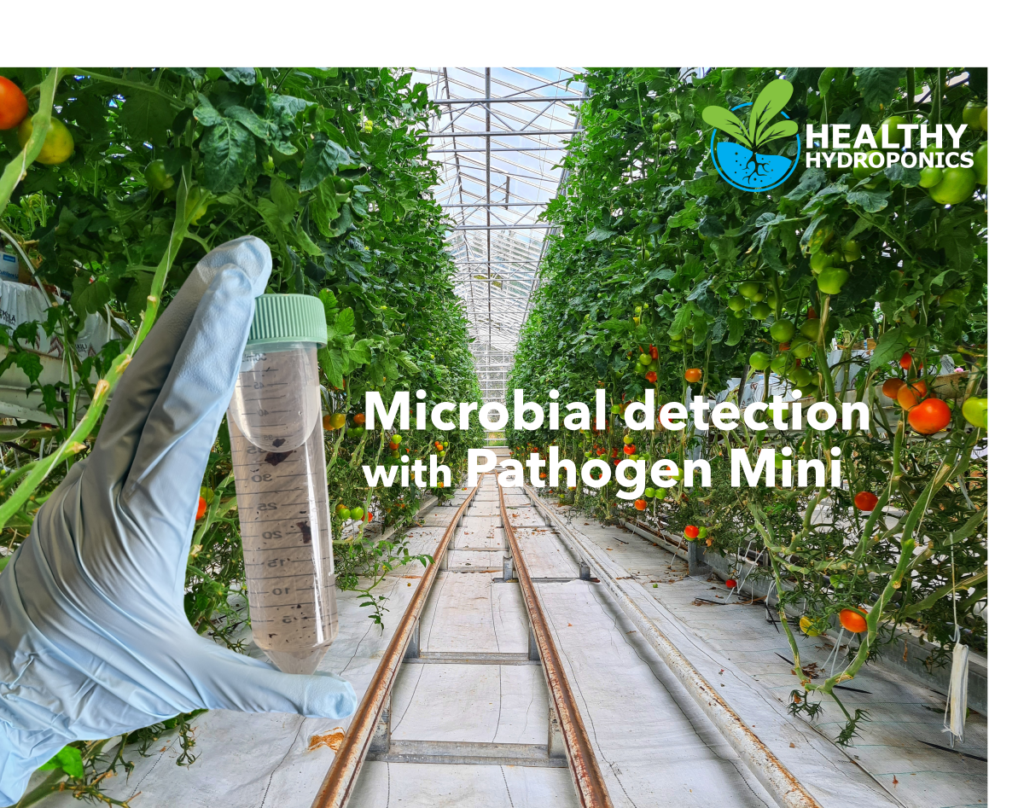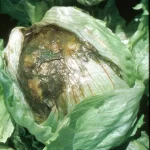Up to 40% of global crop loss is due to pests and plant diseases costing the global economy over $220 billion annually estimated by The Food and Agriculture Organization of the United Nations (FAO).
Plant pathogens are not just a problem in traditional field agriculture, but also in indoor farms such as greenhouses and vertical farms that use hydroponic technology. Pythium root rot notoriously affects many hydroponic crops such as cucumber, tomatoes, spinach, and lettuce. While the Tomato Brown Rugose Fruit Virus (ToBRFV) has been rapidly infecting tomatoes across the globe costing farmers hundreds of millions of dollars in the past few years.
Although indoor hydroponic systems eliminate much of soilborne pathogens, recirculating irrigation water, indoor air quality, and any resource, object, or person entering or within the farm can pose a threat or mode for pathogens to proliferate. What can be done when farms and crops can be vulnerable to pathogens all around?
Prevention, monitoring, and control are the most effective ways to protect crop production. If you’re a grower, you probably already know that.
Growers take preventative measures such as routinely scrubbing out pipes, adding a disinfectant to the water supply, installing ventilation, adding in biocontrol/bioinoculants, and practising good sanitation–just to name a few. These are excellent and laborious steps to minimize and control opportunities for microorganisms and pathogens to overgrow or transmit to different parts of the farm. However, it is impossible to absolutely prevent microorganisms and pathogens from entering farms and being transmitted via e.g. seeds, plants, water supply, air, equipment, personnel, and visitors.
Not only are regular monitoring and controlling the nutritional input and environmental growing conditions critical but the microbiome and pathogens in the farm are also important to keep plants growing and healthy. The sighting of disease symptoms in plants and fruits indicates that there has been an imbalance in the working relationships among the environment, plants, and or pathogen(s). Monitoring the microbiome (microbial community) and particular pathogens help growers keep pathogens in check. Monitoring provides an opportunity to detect pathogens earlier and to take precautionary or mitigative measures sooner.
Healthy Hydroponics offers Pathogen+ as a service to growers to monitor the pathogen load over time. Since 2020, we’ve worked hard to understand hydroponic microbiomes in order to provide a microbial monitoring service with the help of growers.
Pathogen Mini
This week, I would like to introduce you to a new pathogen detection offering from Healthy Hydroponics: Pathogen Mini. Pathogen Mini is a quick and simple test that can be used as a precautionary measure to detect pathogens early in asymptomatic samples. It can also be used as a pathogen detection test in symptomatic samples. Each test detects the presence of one specific pathogen in a sample. Results are provided within 2-3 business days upon receiving samples. Pathogen Mini uses qPCR technology for detecting bacteria, fungi, and fungal-like organisms or RT-qPCR for viruses. Growers can collect samples such as water, leachate, and plant material e.g. leaves, roots, etc and send it to us for testing.
Pathogen Mini is offered as a one-time testing or subscription-based testing (starting at eight tests per month). The monthly, subscription-based testing provides growers with the opportunity to do testing more routinely for a discounted price. The eight tests can be comprised of different pathogens of interest allowing for flexibility and range of detection at any given time in a month.
The advantages of Healthy Hydroponics’ Pathogen Mini:
- A quick test that provides growers with a simple result within 2-3 business days allowing growers to take action early
- Monitor the pathogen of interest in asymptomatic samples as a precautionary measure
- Detect the pathogen of interest in symptomatic samples as a mitigation/controlling measure
- Discounts on routine monitoring with the subscription service; save money while keeping pathogens in check
- Track results in Healthy Hydroponics’ Grower’s Portal which shows all test results over time in one convenient place! No need to look for results in scattered files!
Interested? Check out Pathogen Mini and Pathogen+ on our Services page.
Healthy Hydroponics’ Grower’s Portal
The Grower’s Portal is a platform that will provide growers with the results of all samples from Pathogen+ and Pathogen Mini tests submitted to Healthy Hydroponics. It is a comprehensive and interactive portal reporting the pathogens present and their load in multiple samples submitted over time. We will have more information about Healthy Hydroponics’ Grower Portal in the upcoming weeks as we get ready to reveal a pilot version of the platform!
See the diseases you should be protecting yourself from by subscribing to our newsletter
Pathogen Mini for ToBRFV monitoring and control
We are offering Pathogen Mini targeting common pathogens in hydroponic farms. We are starting the service off with Pathogen Mini which checks for the presence of the Tomato Brown Rugose Fruit Virus (ToBRFV).
Growers are currently facing the most challenging and serious threat to tomato production being the highly transmissible ToBRFV. This virus is affecting countless greenhouses in at least 35 countries across four continents as of May 2022. Symptoms of ToBRFV can show up 10-14 days after infection or even as long as 30 days. Thus, early and regular monitoring and detection in specific areas of the greenhouses can help with controlling and minimizing the damage in known sections of the farm. Growers can take mitigation measures to address transmission if the virus is detected in an area. The best approach to controlling a pathogen as infectious and transmissible as ToBRFV is early and vigilant monitoring and detection. See FAQs below for some possible strategies to sample a greenhouse.
We are working to add other common hydroponic pathogens detectable using Pathogen Mini. Let us know if you have any suggestions at [email protected].
Below are FAQs summarizing the information about Pathogen Mini in this blog post.
FAQs – Pathogen Mini
What is Pathogen Mini?
It is a pathogen detection service that aims to detect the presence of one pathogen per test. Growers can track the results of multiple samples in the Healthy Hydroponics’ Grower Portal over time.
What kind of pathogens can be detected using Pathogen Mini?
Currently, Pathogen Mini detects Tomato Brown Rugose Fruit Virus. We are working on expanding the list of pathogens detected by Pathogen Mini.
What kind of samples can I use Pathogen Mini to detect pathogens?
Submit any type of samples in which the pathogen is suspected to infect or in which symptoms manifest e.g. roots for root rot disease, tomato fruits or leaves for ToBRFV. See our Sample Submission Guidelines for information on how to send samples.
What kind of result would I get from Pathogen Mini?
Pathogen Mini offers a presence/absence result for each sample analyzed.
What is the turnaround time for Pathogen Mini?
The turnaround time for Pathogen Mini is 2-3 business days from receiving the samples.
How much does Pathogen Mini cost?
Please refer to our Services page.
What kind of technology does Pathogen Mini use to detect pathogens?
Pathogen Mini detects the pathogen by its DNA using qPCR technology for bacteria, fungi, and fungal-like organisms or RT-qPCR for viruses.
Does Pathogen Mini detect live pathogens?
Pathogen Mini does not discriminate between dead or live pathogens.
Should I divide symptomatic and asymptomatic samples?
Yes, please bag symptomatic and asymptomatic samples separately.
My greenhouse is huge. How do I select samples to check for pathogens?
We suggest dividing your greenhouse into sections and selecting a number of subsamples from a section.
For example: if testing leaves, you can subsample in the following but not limited to these ways:
- Select leaves from plants every X number of plants in one row; you can repeat this process for another row in the same section
- Select leaves in a Z-shaped pattern of plants in a section
- Randomly select X number of leaves in a section
- Composite sampling: select 5 leaves in a row or a quarter of the section and repeat for the next row or quarter in the section.
Since greenhouse setups are different in size and set up from farm to farm, we would be happy to advise on sampling approaches for your farm. Contact us at [email protected].
What if the pathogen I am interested in is not detected by Pathogen Mini?
Let us know which pathogen you are interested in! We are working on expanding the list of pathogens detected by Pathogen Mini.
Are you looking for more helpful info? Go back to the Blog Page or check out the Resources Page.
![]()
Rebecca Co is the Manager of Healthy Hydroponics, and Innovation and Research.





